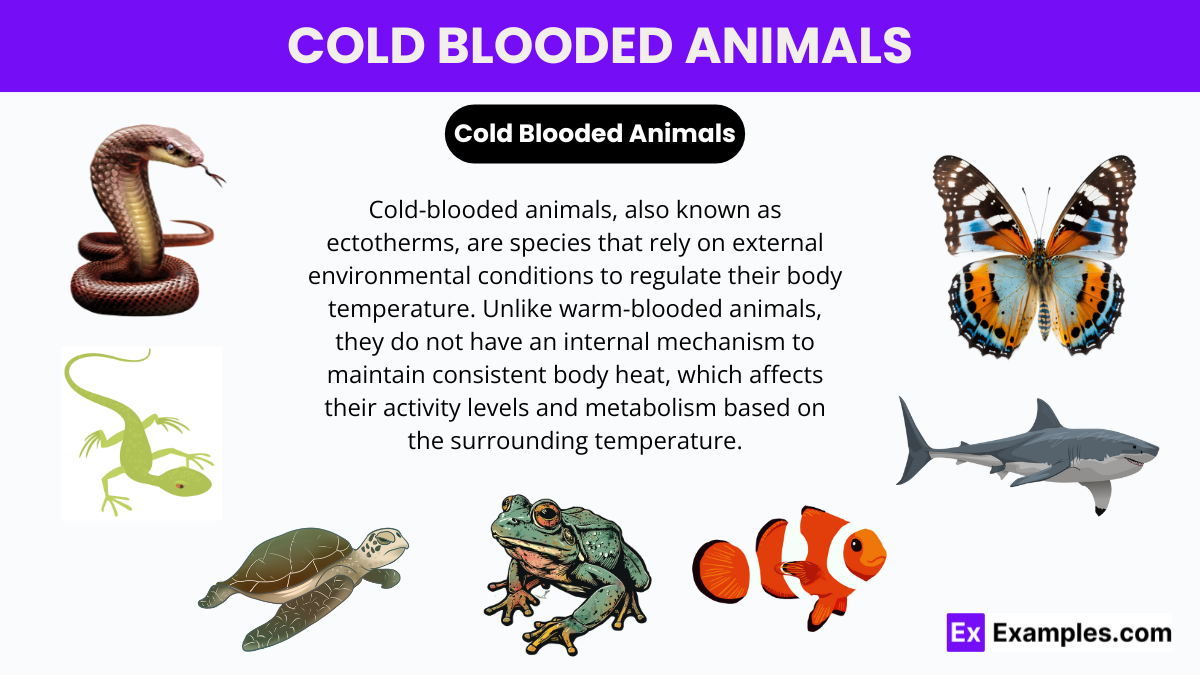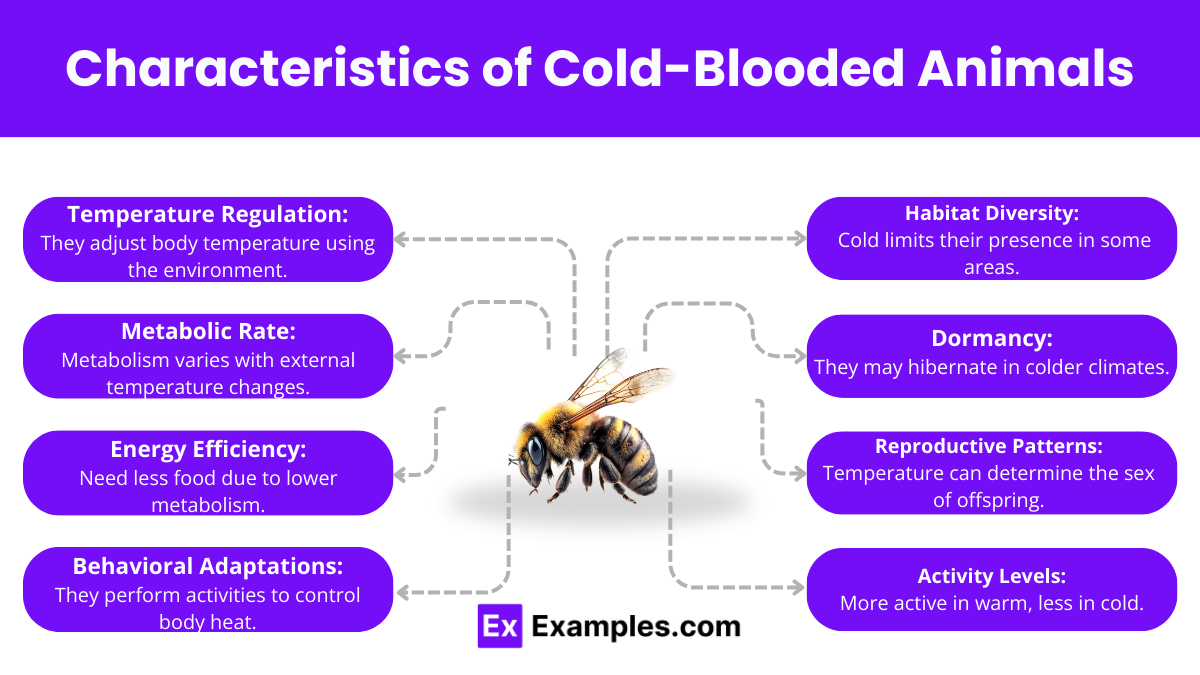Which of the following animals is cold-blooded?
Dolphin
Frog
Penguin
Whale


Cold-blooded animals, or poikilotherms, rely on environmental conditions to regulate their body temperature. Unlike warm-blooded species, these creatures do not generate their own heat. Instead, they must adapt to their surroundings to maintain their body temperature. This adaptation can include basking in the sun to raise their temperature or seeking shade and cool areas to lower it. This dependence on external heat sources makes them highly susceptible to temperature fluctuations, which can greatly influence their activity levels and survival. Cold-blooded animals include a diverse group such as reptiles, amphibians, fish, and insects, each uniquely adapted to their thermal environment.
Cold-blooded animals, or ectotherms, are species that regulate their body temperature according to the environment. This group includes reptiles, amphibians, fish, and invertebrates. They do not generate their own heat but instead rely on external sources like sunlight to warm up. Key characteristics include variable body temperatures, low food requirements due to minimal energy spent on heat production, and behaviors such as basking or seeking shade to manage their temperature.

Cold-blooded animals do not regulate their internal body temperature through metabolic processes. Instead, their body temperature fluctuates with the ambient environment. This means they become warmer or cooler depending on the surrounding temperatures. For example, a lizard will sunbathe to increase its body temperature and seek shade or a burrow to cool down.
Because they do not need to maintain a constant body temperature, cold-blooded animals are more energy-efficient compared to warm-blooded animals. They require less food because they expend less energy on heating or cooling their bodies. This low energy requirement allows them to survive longer periods without food.
To manage their body temperature, cold-blooded animals exhibit various behavioral adaptations. Common behaviors include basking in the sun to warm up and finding cool areas or submerging in water to lower their body temperature. These behaviors help them to thermoregulate effectively without the need for internal thermal regulation mechanisms.
The dependency on external heat sources often influences the habitats cold-blooded animals choose and their patterns of activity. Many cold-blooded species are more active during the warmer parts of the day and may become dormant during colder periods. Seasonal changes can also impact their activity, leading to hibernation or aestivation during extreme temperatures.
Temperature affects the metabolic and reproductive rates of cold-blooded animals. In warmer conditions, their metabolism speeds up, which can lead to faster growth and quicker reproduction. Conversely, cooler temperatures can slow down these processes.
Cold-blooded animals, or ectotherms, rely on external sources of heat to regulate their body temperature. During winter, when temperatures drop significantly, these animals employ various strategies to survive the harsh conditions. Here’s how different groups of cold-blooded animals cope with winter:
Cold Water Habitats: Fish adapt to lower temperatures by moving to deeper waters where temperatures are more stable and do not reach freezing points. Some fish, like carp and goldfish, slow their metabolism so much that they require very little oxygen and can survive in water that is nearly freezing.
Ectothermy, or cold-bloodedness, offers several distinct advantages to animals. These creatures do not need to maintain a constant body temperature, which allows for a greater variety of body sizes—from minuscule insects to vast crocodiles—since the ratio of body weight to surface area is less critical. The variable body temperature of ectotherms also makes them less attractive hosts for parasites, thereby reducing the risk of diseases. Furthermore, because they do not use food to generate heat, cold-blooded animals can survive long periods without eating, with some species, like certain snakes, only needing to feed once a month. During times of food scarcity, they can significantly reduce their activity levels, conserving energy effectively. Most of the food they consume is used for growth rather than heat production, making them highly efficient in converting food into body mass.
However, ectothermy also comes with notable disadvantages. These animals are generally confined to warmer climates, as their activity levels and metabolic rates are directly influenced by environmental temperatures. In cooler temperatures, an ectotherm’s metabolism slows dramatically, which can diminish their ability to find food, escape predators, and perform other necessary functions. If temperatures fall below a critical threshold and remain low for extended periods, it can become lethal for these creatures. This dependency on external heat sources restricts their geographic distribution and can impact their survival during unexpected cold spells.
Cold-blooded animals can become lethargic in cold conditions but have adaptations to avoid freezing, such as burrowing or entering a dormant state.
Humans are warm-blooded mammals, meaning they regulate their body temperature internally, unlike cold-blooded creatures.
Cold-blooded animals have sensory responses and can feel stimuli in their environment, similar to warm-blooded animals.
Cold-blooded animals experience pain. They have nervous systems capable of responding to painful stimuli, indicating distress or discomfort.
Text prompt
Add Tone
10 Examples of Public speaking
20 Examples of Gas lighting
Which of the following animals is cold-blooded?
Dolphin
Frog
Penguin
Whale
Cold-blooded animals are also known as
Endotherms
Ectotherms
Homeotherms
Thermoregulators
Which of the following is NOT a characteristic of cold-blooded animals?
Rely on environmental heat sources
Have a variable body temperature
Can maintain a constant body temperature
Often bask in the sun
Which of these reptiles is cold-blooded?
Lion
Penguin
Elephant
Snake
Cold-blooded animals are most active:
In the morning
During extreme cold
When the environment is warm
At night
How do cold-blooded animals regulate their body temperature?
By sweating
By moving to different environments
By shivering
By using internal metabolic processes
Which fish is cold-blooded?
Tuna
Shark
Salmon
All of the above
What is one advantage of being a cold-blooded animal?
Need more food to maintain body temperature
Can survive with less food
Always active regardless of temperature
Can generate own body heat
Amphibians are cold-blooded. Which of the following is an amphibian?
Lizard
Toad
Crocodile
Turtle
In which environment would you least likely find cold-blooded animals?
Tropical rainforest
Desert
Polar regions
Temperate forest
Before you leave, take our quick quiz to enhance your learning!

